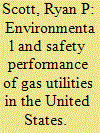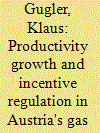| Srl | Item |
| 1 |
ID:
168663


|
|
|
|
|
| Summary/Abstract |
The performance of energy service providers has important environmental and safety consequences in local communities. This paper uses a novel dataset compiled from operator reports and infrastructure monitoring data obtained from three different US federal agencies to assess the performance of retail gas utilities nationwide in terms of addressing gas leaks and minimizing leaked volume. Our panel data set includes yearly observations for 727 retail gas utilities from 2009 to 2017. We show that safety hazards and environmental costs of gas leaks are widespread across providers that vary in terms of ownership, size, and region. We then use a series of Bayesian hierarchical models to regress four outcome variables—hazardous leaks, end-year unfixed leaks, total gas volume leaked, and significant incidents—on infrastructure conditions, regional service context, and socio-economic service population characteristics. Unlike what is observed in other critical infrastructure cases such as drinking water, socio-economic conditions are not strongly predictive of service outcomes. Additionally, public utilities exhibit better environmental performance on average, and no difference in maintenance backlogs. Because the environmental costs of poor performance--primarily in terms of methane greenhouse gas emissions--are predominantly social, policy tools such as consolidation and privatization are unlikely to improve environmental outcomes.
|
|
|
|
|
|
|
|
|
|
|
|
|
|
|
|
| 2 |
ID:
169750


|
|
|
|
|
| Summary/Abstract |
The projected rate of productivity growth is the critical determinant of the price cap in incentive regulation. However, the regulatory authorities generally lack sophisticated industry TFP studies to set an optimal cap. We thus estimate productivity growth in the Austrian gas distribution sector in a translog cost function framework. A key feature is our unique panel database on costs and outputs of regulated utilities for the period 2002–2013, covering six years prior and during incentive regulation as introduced in 2008. We find a modest TFP growth rate in the early sample years, followed by a decline to zero or even slightly negative rates in recent years. We also find a significant potential for returns to scale, which is left unexploited, indicating that utilities could significantly save on costs by merging. As essential investments have already been undertaken in the past, opportunities for technological progress seem to be limited in recent years.
|
|
|
|
|
|
|
|
|
|
|
|
|
|
|
|
| 3 |
ID:
127198


|
|
|
|
|
| Publication |
2014.
|
| Summary/Abstract |
This paper studies the cost structure of Swiss gas distribution utilities. Several econometric models are applied to a panel of 26 companies over 1996-2000. Our main objective is to estimate the optimal size and scale economies of the industry and to study their possible variation with respect to network characteristics. The results indicate the presence of unexploited scale economies. However, very large companies in the sample and companies with a disproportionate mixture of output and density present an exception. Furthermore, the estimated optimal size for majority of companies in the sample has shown a value far greater than the actual size, suggesting remarkable efficiency gains by reorganization of the industry. The results also highlight the effect of customer density on optimal size. Networks with higher density or greater complexity have a lower optimal size
|
|
|
|
|
|
|
|
|
|
|
|
|
|
|
|